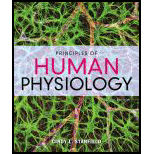
Principles of Human Physiology (6th Edition)
6th Edition
ISBN: 9780134169804
Author: Cindy L. Stanfield
Publisher: PEARSON
expand_more
expand_more
format_list_bulleted
Question
Chapter 18.5, Problem 3CTQ
Summary Introduction
To write:
About the relative advantages and disadvantages of the different treatments available for urinary incontinence.
Introduction:
Urinary system or renal system helps in eliminating wastes from the body, regulating blood pressure, volume as well as in controlling electrolyte, metabolites levels. The urinary system has two kidneys, two ureters, one urinary bladder and one urethra.
Urine gets stored in the urinary bladder and is then released from the body. When the urine is lost unintentionally because of loss of urinary bladder control, it is called urinary incontinence.
Expert Solution & Answer
Want to see the full answer?
Check out a sample textbook solution
Students have asked these similar questions
Explain in a small summary how:
What genetic information can be obtained from a Punnet square? What genetic information cannot be determined from a Punnet square?
Why might a Punnet Square be beneficial to understanding genetics/inheritance?
In a small summary write down:
Not part of a graded assignment, from a past midterm
Chapter 18 Solutions
Principles of Human Physiology (6th Edition)
Ch. 18.2 -
Describe the symptoms that indicate the presence...Ch. 18.2 - What treatments are available for removing or...Ch. 18.2 - Prob. 3CTQCh. 18.2 - Prob. 18.1.1QCCh. 18.2 - Prob. 18.1.2QCCh. 18.2 - Prob. 18.1.3QCCh. 18.2 - Prob. 18.1.4QCCh. 18.3 - Indicate whether the GFR will tend to rise or fall...Ch. 18.3 - Prob. 18.2.2QCCh. 18.3 -
Is the control of afferent and efferent...
Ch. 18.3 -
Describe the barriers for reabsorption and...Ch. 18.3 -
Describe the general mechanism of water...Ch. 18.3 -
Define the terms transport maximum and renal...Ch. 18.3 - Prob. 1CTQCh. 18.3 - Prob. 2CTQCh. 18.3 - Prob. 3CTQCh. 18.5 - Prob. 1CTQCh. 18.5 - Prob. 2CTQCh. 18.5 - Prob. 3CTQCh. 18.5 - Prob. 18.4.1QCCh. 18.5 - Prob. 18.4.2QCCh. 18.5 - Prob. 18.4.3QCCh. 18.5 -
Describe the innervation of the bladder,...Ch. 18 - Prob. 1ECh. 18 -
Which of the following is not one of the...Ch. 18 - Which type of specialized junction connects...Ch. 18 - Which of the following does not favor a large...Ch. 18 - Prob. 5ECh. 18 - Prob. 6ECh. 18 - Which of the following would occur if mean...Ch. 18 - Prob. 8ECh. 18 - Prob. 9ECh. 18 - Prob. 10ECh. 18 -
Micturition occurs in response to
a Relaxation...Ch. 18 - The (ureter/urethra) carries urine from the...Ch. 18 - Urinary excretion is the elimination of urine from...Ch. 18 -
The (afferent/efferent) arteriole carries blood...Ch. 18 - Prob. 15ECh. 18 - Prob. 16ECh. 18 - Prob. 17ECh. 18 - Prob. 18ECh. 18 - Prob. 19ECh. 18 - Prob. 20ECh. 18 - Prob. 21ECh. 18 - Prob. 22ECh. 18 -
Substances that are reabsorbed move into the...Ch. 18 - An increase in the flow rate through the macula...Ch. 18 -
Glucose reabsorption occurs primarily in the...Ch. 18 -
Describe the pathway of filtrate flow from the...Ch. 18 - Explain why the glomerular filtration rate does...Ch. 18 - Prob. 28ECh. 18 - Explain the concept of transport maximum. Why does...Ch. 18 - Prob. 30ECh. 18 - Prob. 31ECh. 18 - Prob. 32ECh. 18 - Prob. 33ECh. 18 -
Compare the responses of the smooth muscle in...
Knowledge Booster
Similar questions
- Noggin mutation: The mouse, one of the phenotypic consequences of Noggin mutationis mispatterning of the spinal cord, in the posterior region of the mouse embryo, suchthat in the hindlimb region the more ventral fates are lost, and the dorsal Pax3 domain isexpanded. (this experiment is not in the lectures).a. Hypothesis for why: What would be your hypothesis for why the ventral fatesare lost and dorsal fates expanded? Include in your answer the words notochord,BMP, SHH and either (or both of) surface ectoderm or lateral plate mesodermarrow_forwardNot part of a graded assignment, from a past midtermarrow_forwardNot part of a graded assignment, from a past midtermarrow_forward
- please helparrow_forwardWhat does the heavy dark line along collecting duct tell us about water reabsorption in this individual at this time? What does the heavy dark line along collecting duct tell us about ADH secretion in this individual at this time?arrow_forwardBiology grade 10 study guidearrow_forward
arrow_back_ios
SEE MORE QUESTIONS
arrow_forward_ios
Recommended textbooks for you
 Human Anatomy & Physiology (11th Edition)BiologyISBN:9780134580999Author:Elaine N. Marieb, Katja N. HoehnPublisher:PEARSON
Human Anatomy & Physiology (11th Edition)BiologyISBN:9780134580999Author:Elaine N. Marieb, Katja N. HoehnPublisher:PEARSON Biology 2eBiologyISBN:9781947172517Author:Matthew Douglas, Jung Choi, Mary Ann ClarkPublisher:OpenStax
Biology 2eBiologyISBN:9781947172517Author:Matthew Douglas, Jung Choi, Mary Ann ClarkPublisher:OpenStax Anatomy & PhysiologyBiologyISBN:9781259398629Author:McKinley, Michael P., O'loughlin, Valerie Dean, Bidle, Theresa StouterPublisher:Mcgraw Hill Education,
Anatomy & PhysiologyBiologyISBN:9781259398629Author:McKinley, Michael P., O'loughlin, Valerie Dean, Bidle, Theresa StouterPublisher:Mcgraw Hill Education, Molecular Biology of the Cell (Sixth Edition)BiologyISBN:9780815344322Author:Bruce Alberts, Alexander D. Johnson, Julian Lewis, David Morgan, Martin Raff, Keith Roberts, Peter WalterPublisher:W. W. Norton & Company
Molecular Biology of the Cell (Sixth Edition)BiologyISBN:9780815344322Author:Bruce Alberts, Alexander D. Johnson, Julian Lewis, David Morgan, Martin Raff, Keith Roberts, Peter WalterPublisher:W. W. Norton & Company Laboratory Manual For Human Anatomy & PhysiologyBiologyISBN:9781260159363Author:Martin, Terry R., Prentice-craver, CynthiaPublisher:McGraw-Hill Publishing Co.
Laboratory Manual For Human Anatomy & PhysiologyBiologyISBN:9781260159363Author:Martin, Terry R., Prentice-craver, CynthiaPublisher:McGraw-Hill Publishing Co. Inquiry Into Life (16th Edition)BiologyISBN:9781260231700Author:Sylvia S. Mader, Michael WindelspechtPublisher:McGraw Hill Education
Inquiry Into Life (16th Edition)BiologyISBN:9781260231700Author:Sylvia S. Mader, Michael WindelspechtPublisher:McGraw Hill Education

Human Anatomy & Physiology (11th Edition)
Biology
ISBN:9780134580999
Author:Elaine N. Marieb, Katja N. Hoehn
Publisher:PEARSON

Biology 2e
Biology
ISBN:9781947172517
Author:Matthew Douglas, Jung Choi, Mary Ann Clark
Publisher:OpenStax

Anatomy & Physiology
Biology
ISBN:9781259398629
Author:McKinley, Michael P., O'loughlin, Valerie Dean, Bidle, Theresa Stouter
Publisher:Mcgraw Hill Education,

Molecular Biology of the Cell (Sixth Edition)
Biology
ISBN:9780815344322
Author:Bruce Alberts, Alexander D. Johnson, Julian Lewis, David Morgan, Martin Raff, Keith Roberts, Peter Walter
Publisher:W. W. Norton & Company

Laboratory Manual For Human Anatomy & Physiology
Biology
ISBN:9781260159363
Author:Martin, Terry R., Prentice-craver, Cynthia
Publisher:McGraw-Hill Publishing Co.

Inquiry Into Life (16th Edition)
Biology
ISBN:9781260231700
Author:Sylvia S. Mader, Michael Windelspecht
Publisher:McGraw Hill Education